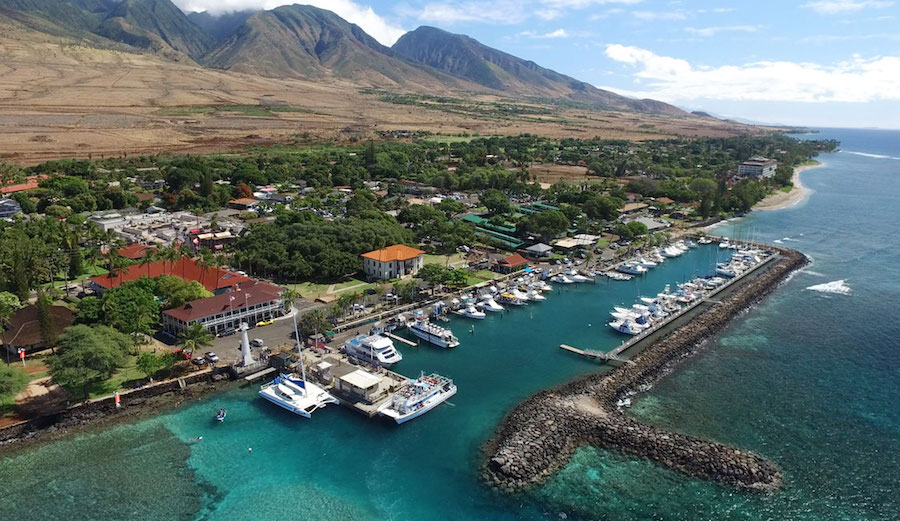 |
 |
Protect Lahaina’s Coast: Tell Maui County to Stop Pumping Treated Sewage Into the Pacific
|
Lahaina News
July 9, 2019
Molly Bruce
Summer Legal Intern, Surfrider Foundation
COMMUNITY

View of Lahaina Town and Harbor
Treated sewage wastewater represents almost 15 percent of the total groundwater entering the Pacific near Lahaina. Photo: mauiguide.com
Maui County's Lahaina Wastewater Reclamation Facility (LWRF) has illegally discharged treated wastewater for nearly 40 years. It has disposed of an average of 4 million gallons of treated wastewater per day into injection wells. These injection wells then drain into the Pacific Ocean by way of groundwater. This amount of treated sewage wastewater represents almost 15 percent of the total groundwater entering the Pacific near Lahaina. It has dramatically and negatively impacted the Kahekili Beach area, the local tourism industry, and the public's ability to access pristine beaches by inducing substantial coral declines, eroding marine habitats, introducing astronomical levels of nutrients to the marine ecosystem that spur dead zones, and raising concerns about risks to public health. Surfrider calls upon Maui citizens, marine health advocates, and other interested parties to reach out to Maui County urging them to halt their violations of the Clean Water Act (CWA).
For more than a decade, the Surfrider Foundation, Maui citizens, and other public interest organizations have used a variety of non-litigious methods to encourage LWRF to cease its CWA violations. Nonetheless, LWRF refused to adjust its wastewater disposal procedures. Ultimately, in an effort to resolve this environmentally disastrous situation, the Surfrider Foundation — in coordination with Hawai'i Wildlife Fund, Sierra Club-Maui Group, and West Maui Preservation Association — sued the County of Maui in 2012 for violating the CWA.
The CWA seeks to "restore and maintain the chemical, physical, and biological integrity of the Nation's waters" by barring the "discharge of any pollutant." Discharge of pollutant is defined as "any addition of any pollutant to navigable waters from any point source." Point source is defined as "any discernible, confined and discrete conveyance…from which pollutants are or may be discharged." Navigable waters are defined as "waters of the United States, including the territorial seas," though the breadth of the term is still being contested.
LWRF was found guilty of CWA violations at the U.S District Court for the District of Hawai'i in 2018 and at the federal Court of Appeals for the Ninth Circuit in 2014. The LWRF injection wells qualify as point sources and the Pacific Ocean qualifies as a navigable waterway for purposes of the CWA. Ultimately, this case calls into question whether LWRF and other polluters can perpetrate indirectly what the law currently bars them from doing directly; if LWRF is prohibited from sending treated wastewater directly into the Pacific Ocean absent a National Pollutant Discharge Elimination System (NPDES) permit, can it evade this requirement simply by sending the wastewater into injection wells where the wastewater intermingles with groundwater before draining into the Pacific? The EPA clarified its stance on the issue nearly thirty years ago, stating, "the affected groundwaters are not considered 'waters of the United States' but discharges to them are regulated because such discharges are effectively discharges to the directly connected surface waters."
In a resounding sign of support for the public's rights guaranteed under the CWA, the district court and the appellate court both agreed that LWRF was guilty of illegally discharging point source pollutants into navigable waters. The Ninth Circuit wrote, "[t]he County could not under the CWA build an ocean outfall to dispose of pollutants directly into the Pacific Ocean without an NPDES permit. It cannot do so indirectly either to avoid CWA liability. To hold otherwise would make a mockery of the CWA's prohibitions."
However, LWRF has not rectified the dangers to marine and human health, it has not amended its wastewater disposal policies, and it has not settled the lawsuit. Instead, the County has opted to spend millions of taxpayer dollars fighting its CWA-based responsibilities to safeguard public health and water supplies. Contrary to legal community expectations, the U.S. Supreme Court has agreed to hear the case on appeal from the Ninth Circuit. Still, Surfrider seeks to resolve this situation outside of court rather than rely on additional protracted litigation.
To avoid further litigation, Surfrider and its partners need your help. Please sign the petition asking Maui County to settle the Lahaina Injection Well Lawsuit and work with the community to find alternative long-term solutions that will protect Maui's reefs and beaches, and ensure continued protections under the Clean Water Act for all Americans.
Learn more about Surfrider's continued efforts on Maui here.
Original article URL:
https://www.theinertia.com/environment/maui-county-lahaina-wastewater-reclamation-facility-environment-wastewater-pollution/
BACK TO WMPA
HOME PAGE
|


